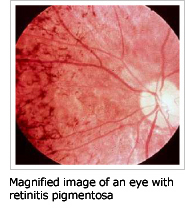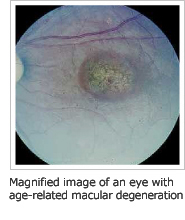|
NEWS: We are happy to have the Optobionics website back up. The original Optobionics Corporation has stopped operations. However, Dr. Chow has acquired the Optobionics name and the Artificial Silicon Retina (ASR) implants and will be reorganizing a new company under the Optobionics name.
If you are a patient with Retinitis Pigmentosa and would be interested in whether your eye condition may be responsive to ASR chip stimulation, you may contact us using the Contact Us tab or call us at (630) 858-4411 (Please be patient as it may take us a while to respond to you).


|
|
Retinal Disease
|
|
Two common forms of vision loss occur because of disruption or malfunction of the retinal layers and are the conditions which may be responsive to treatment with the Artificial Silicon Retina™ (ASR™) chip. They are:
* Retinitis pigmentosa (RP), and
* Age-related macular degeneration (AMD)
RETINITIS PIGMENTOSA (RP) is a general term for a large number of progressive retinal degenerations that predominately affect the photoreceptor layer or “light sensing” cellular layer of the retina. These conditions can be hereditary or develop as a new condition which may begin to affect individuals’ vision from early to mid-life. Almost all of these conditions will worsen with time.
Degeneration of function of the photoreceptor cell layer reduces the retina’s ability to sense light and dark signals thereby reducing contrast, color perception and visual field size. Despite the degeneration of function in the photoreceptor layer, other retinal processing cells and retinal layers and even many photoreceptors may still be present. Recent studies have shown that a degree of function of these cell layers may be rescued in some instances.
Although different forms of RP can affect various areas of the visual field, most RP patients experience loss of the mid-peripheral vision first in a donut-shape pattern and loss of the far-peripheral and the central vision areas in later years.
The narrowing of the field of vision into “tunnel vision” and generalized loss of contrast and color vision may result in substantial blindness. Specific forms of RP and related conditions include Usher’s Syndrome, Leber’s Congenital Amaurosis, Stargardt’s Disease, Cone-Rod Dystrophy and Choroideremia.
AGE-RELATED MACULAR DEGENERATION (AMD) refers to a predominantly retinal degeneration that becomes more common with advancing age.
AMD primarily affects the highest resolution central portion of the retina known to as the macula. Typically, AMD initially produces a “dry” or geographic form of damage resulting in blind spots. Dry AMD may progress into larger areas of vision loss with the development of a “wet” form that occurs from blood vessel, within the affected retinal areas leaking or bleeding. Scarring of these retinal areas may also occur.
Together, AMD and RP affect approximately 30 million people in the world and are the most common causes of vision loss in developed countries.
|
  |







